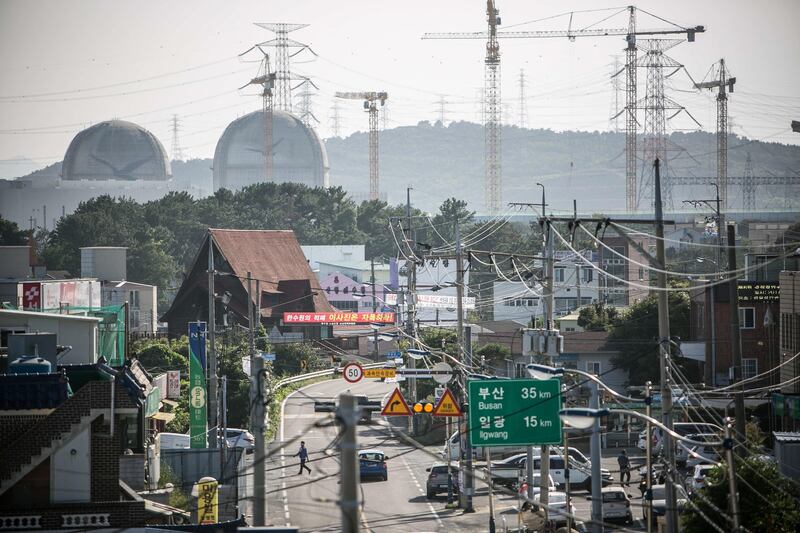On the snowy plains outside Idaho Falls in the north-western US sits a deliberately nondescript brick building.
On December 20, 1951, power from its nuclear reactor lit a string of light-bulbs – the first nuclear-generated electricity in the world. Now researchers at the nearby Idaho National Laboratories, and in a chain of labs and companies across the country, are trying to kick off a new era of cheap, clean nuclear power.
Meanwhile, this Monday sees in Abu Dhabi the four-yearly ministerial gathering on the civilian nuclear power sector. The UAE’s first nuclear power plant, at Barakah in the Western Region, is due to start operations next year, a major shift in the country’s energy mix. Nuclear developers in the US were amazed, and envious, that the UAE could go from nothing to a functioning nuclear power plant within 10 years. Recent nuclear plants in the US, France and Finland have been bedevilled by delays, redesigns, regulatory and legal challenges, and environmentalist opposition.
Nuclear plants have longer construction times than renewable or gas power and must pay for fuel and, ultimately, waste disposal that hydroelectric, solar and wind energy facilities do not require. The overall cost per unit of electricity from Barakah is likely to be above that for a gas or coal-fired power plant, even at international fuel prices but, critically, it does not emit greenhouse gases during operation.
In a world that is moving far too slowly to tackle climate change, nuclear is proven, large-scale and low-carbon. The US department of energy has recently moved to offer subsidies to sustain existing nuclear (and, absurdly, coal) plants on trumped-up national security grounds.
The far better justification for keeping current nuclear power plants alive is to avoid carbon dioxide emissions. Despite Germany’s much-touted “Energiewende” (energy transition) and expansion of renewable energy, its simultaneous decision to phase out nuclear power following Japan’s 2011 Fukushima accident has meant its carbon dioxide emissions have not fallen since 2009.
Green groups are failing to take climate change seriously, instead refighting the battles of the 1970s. There is a legitimate environmental argument about whether to build new nuclear plants; there is no such case for prematurely shutting down safe existing reactors.
But for new nuclear construction to take off, it will have to compete on economic grounds. Current designs are simply too expensive, particularly in the heavy regulatory climate of Europe and North America. Renewable energy – particularly solar and offshore wind power – has advanced dramatically in recent years and battery costs are also coming down. Natural gas is cheap, plants are quick to build and are beating nuclear and coal power in the US particularly.
______________
Read more:
France to decide nuclear shutdown numbers next year
Russia moves to strengthen energy ties with Morocco
With no indigenous fuel sources, Japan is looking to diversify its energy mix
______________
The financing of the Barakah plant amounted to US$24.4 billion, up somewhat from the initial $20.4bn, for 5.6 gigawatts of capacity, or $4.4 million per megawatt. For comparison, Dubai’s recent solar thermal project, capable of generating electricity through night-time hours, was bid at $5.5 million per megawatt. Solar photovoltaic plants are far cheaper per megawatt but, of course, generate only during sunny hours. Their annual output might be around 20 per cent of their notional capacity, compared to a nuclear power plant, which can exceed 90 per cent.
A new generation of entrepreneurs and engineers in the US, UK, South Korea, Japan and other countries is trying to realise advanced nuclear designs. These plants would be inherently safe, not requiring the cumbersome and costly cooling and containment systems of conventional pressurised-water reactors. Cheaper and quicker to build, some are capable of consuming nuclear waste. Some are small modular designs, which could serve isolated communities or smaller markets, or provide heat and power for seawater desalination or industry.
Such advanced reactors include those such as that of the US’ Transatomic and UK’s Moltex, which are cooled not by water but by molten salts, under atmospheric pressure, and operating at higher temperatures and, so, more efficiently. The Bill Gates-backed Terrapower design burns depleted uranium, avoiding the need for enrichment and refuelling, and intends to build its first reactor in China. Nuscale, partly funded by the engineering major Fluor, is planning to complete a demonstration plant in Idaho by 2026 - a small, 50MW reactor buried underground.
A study published in July by the Energy Innovation Reform Project looked at the cost of these advanced designs. It concluded that, after construction of some initial units, costs could come down to as low as $3.8m per megawatt on average, or $2.1m per megawatt for the cheapest design. The resulting cost of electricity would be highly competitive with gas, coal or renewable energy with back-up.
They still face major hurdles of technology, regulation and financing but, given the urgency of the climate emergency, they are worth a bet alongside renewables and other options.
The planet’s trillion-dollar question is which system will be best at providing reliable, year-round, cheap, low-carbon energy? Will it be what most environmental groups are backing today: variable wind and solar energy paired with batteries; other storage and transcontinental power cables? Will it be gas, coal and biomass (wood-fired) plants that capture their carbon dioxide?
Or will it be a new generation of nuclear power?
Robin M Mills is CEO of Qamar Energy, and author of The Myth of the Oil Crisis






